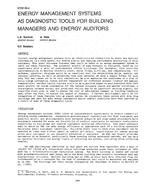Description
Current energy management systems have an underutilized capability to store and analyze information in a form useful for energy audits and ongoing performance monitoring of HVAC equipment. This paper discusses features that could be added to an energy management system to carry out these functions. The potential benefit of such features is evaluated, based on our experience with a pair of instrumented office buildings. For hardware, this involves instrumentation to monitor electric power, water flows, airflows, and temperatures. For software, graphical displays would be an excellent tool for establishing daily, weekly, and seasonal patterns, as well as deviations from such patterns. We show a sample format for such data that has turned out to be very instructive. We also emphasize the usefulness of a plot of daily energy consumption versus ambient temperature (or difference between interior and ambient temperature). Another useful feature would be an algorithm based on past measured data that would predict the energy consumption for the current occupancy status and weather conditions. A discrepancy between actual and predicted values may be an important warning signal; the algorithm could also be used to assess the cost of anticipated changes in building operation and, after the fact, to mesure the impact of changes. A further development would be the integration of these features into an expert system. We illustrate these points with data from buildings and show how much energy consumption and/or comfort conditions have been improved as a result of some of these diagnostic tools.
Units: Dual
Citation: Symposium, ASHRAE Transactions, 1987, vol. 93, pt. 2, Nashville, TN
Product Details
- Published:
- 1987
- Number of Pages:
- 16
- File Size:
- 1 file , 1.2 MB
- Product Code(s):
- D-NT-87-28-4




